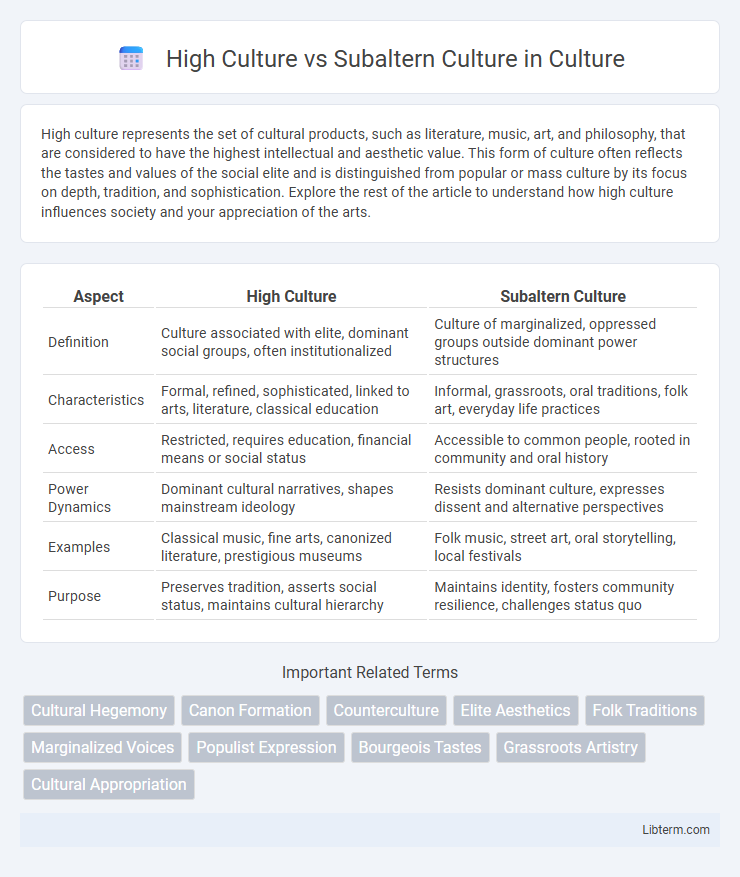High culture represents the set of cultural products, such as literature, music, art, and philosophy, that are considered to have the highest intellectual and aesthetic value. This form of culture often reflects the tastes and values of the social elite and is distinguished from popular or mass culture by its focus on depth, tradition, and sophistication. Explore the rest of the article to understand how high culture influences society and your appreciation of the arts.
Table of Comparison
| Aspect | High Culture | Subaltern Culture |
|---|---|---|
| Definition | Culture associated with elite, dominant social groups, often institutionalized | Culture of marginalized, oppressed groups outside dominant power structures |
| Characteristics | Formal, refined, sophisticated, linked to arts, literature, classical education | Informal, grassroots, oral traditions, folk art, everyday life practices |
| Access | Restricted, requires education, financial means or social status | Accessible to common people, rooted in community and oral history |
| Power Dynamics | Dominant cultural narratives, shapes mainstream ideology | Resists dominant culture, expresses dissent and alternative perspectives |
| Examples | Classical music, fine arts, canonized literature, prestigious museums | Folk music, street art, oral storytelling, local festivals |
| Purpose | Preserves tradition, asserts social status, maintains cultural hierarchy | Maintains identity, fosters community resilience, challenges status quo |
Defining High Culture and Subaltern Culture
High culture refers to the set of cultural products, practices, and values that are esteemed by society's elite, including classical art, literature, and formal institutions like opera and museums. Subaltern culture encompasses the beliefs, traditions, and artistic expressions of marginalized or lower-status groups, often overlooked or suppressed by dominant cultural narratives. These two cultural spheres represent contrasting power dynamics in cultural production and access.
Historical Origins and Evolution
High culture, rooted in the traditions of aristocracy and intellectual elites, originated from classical antiquity and Renaissance Europe, emphasizing literature, fine arts, and formal education. Subaltern culture emerged from marginalized and oppressed groups, reflecting grassroots expressions, oral traditions, and resistance to dominant societal norms. Over time, these cultural forms evolved through social struggles, colonial histories, and power dynamics, shaping distinct identities and modes of cultural production.
Key Characteristics of High Culture
High culture is characterized by its association with elite social classes, emphasizing classical arts, literature, and intellectual achievements often preserved in institutions like museums and universities. It values complexity, tradition, and exclusivity, promoting canonical works and formal education as markers of cultural capital. High culture often contrasts with popular or subaltern cultures by privileging refined tastes and historical continuity over mass appeal or localized, grassroots expressions.
Distinctive Features of Subaltern Culture
Subaltern culture is characterized by its resistance to dominant cultural norms, often emerging from marginalized social groups with limited access to institutional power. It includes oral traditions, grassroots practices, and alternative modes of expression that challenge hegemonic narratives and articulate local identities. Distinctive features include collective memory rooted in lived experiences, subversive folklore, and a focus on survival strategies within oppressive socio-economic conditions.
Representation in Literature and Arts
High culture in literature and arts is traditionally associated with elite, canonical works that emphasize sophistication, formal techniques, and historical significance, often reflecting dominant social values. Subaltern culture represents marginalized voices and experiences, frequently expressed through oral traditions, folk art, and alternative narratives challenging mainstream representations. Literary and artistic representation of subaltern culture expands cultural diversity by highlighting resistance, identity, and socio-political critique often excluded from high culture canons.
Power Dynamics and Social Hierarchies
High culture often symbolizes dominant power structures, reinforcing social hierarchies by privileging elite tastes and values, which marginalize subaltern cultures. Subaltern culture, produced by marginalized groups, resists and challenges these power dynamics through alternative narratives and practices that highlight social inequalities. The tension between these cultural forms reveals how cultural capital and hegemonic control operate to maintain or contest established social orders.
Language, Symbols, and Communication
High culture utilizes formal language, refined symbols, and codified communication channels to maintain exclusivity and social hierarchy. Subaltern culture embraces vernacular dialects, grassroots symbols, and informal communication to express resistance and foster communal identity. The interplay between these linguistic and symbolic systems reveals power dynamics and cultural negotiation within societies.
Impact on Identity and Community
High culture shapes identity through established traditions, classical arts, and elitist values that often reinforce social hierarchies and exclusive community membership. Subaltern culture emerges from marginalized groups, fostering a sense of belonging and resistance by preserving indigenous languages, folk practices, and grassroots knowledge. The dynamic tension between high culture and subaltern culture impacts social cohesion, influencing how communities negotiate power, representation, and cultural legitimacy.
Contemporary Challenges and Resistance
Contemporary challenges to high culture include elitism and limited accessibility, which often marginalize subaltern cultures by privileging dominant narratives and aesthetic norms. Subaltern cultures resist these constraints through grassroots movements, alternative media, and the reclamation of indigenous and marginalized identities, challenging hegemonic cultural representations. This dynamic interplay fosters ongoing debates about cultural legitimacy, power, and inclusivity in globalized, multicultural societies.
Bridging the Gap: Towards Cultural Inclusion
Bridging the gap between high culture and subaltern culture requires recognizing the intrinsic value of diverse cultural expressions beyond traditional elite frameworks. Emphasizing inclusive cultural policies and participatory platforms fosters mutual respect and democratizes access to art, literature, and heritage. Integrating community voices and subaltern narratives enhances cultural pluralism and challenges hegemonic norms in society.
High Culture Infographic

 libterm.com
libterm.com